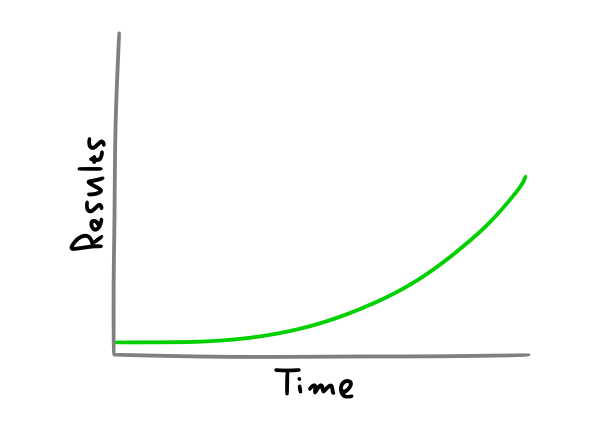Put yourself on the Productive Path

Modern work is complex. It can be overwhelming.
Because we don’t like to be overwhelmed, we often escape this feeling by avoiding work and also looking for the perfect path to take… A path that would make the work easier.
Looking for the perfect path is usually a waste of time, which is why we have a metaphor for you to simplify the situation, help you stay patient, and focus better on the daily actions you need to take.
Say you have a goal. You can imagine that goal as the summit of a mountain.
Now, how do you reach that goal?
You pick a path that probably leads to it, and you start walking. Step by step.
Here's the key thing:
So long as you're moving and are on the path, you're going to reach that goal. You're going to get there.
It might not be the perfect path but it doesn’t have to be.
Some examples:
So long as you stay in a caloric deficit, you will lose weight.
So long as you write a sentence or more a day, you will eventually have enough material for a book.
So long as you keep running or walking, you will finish a marathon.
It is simple, though it can be hard. Because it’s hard, people look for the perfect path as a way of procrastinating instead. They think, instead of taking imperfect action.
Let’s avoid that trap.
Stage #1: Start with the most approachable path
Many people have an epiphany, and then want to change everything: go to gym every day, study for 4 hours every day, meditate for an hour... That approach can yield great results, if your motivation and environment are good enough. However, it often leads to crashing and burning, fast.
Just like when climbing a hill, you probably don't want to take the steepest path that leads right through the thorny bushes.
No, you want to pick a path that perhaps winds around a bit and offers some good views (rewards along the way).
Now how does this apply to procrastination?
What do you want to do that you've been putting off?
Coding? Writing? Working out?
What's the approachable path?
Writing a function or 2 every day? Reading some documentation?
Writing a page per day?
Doing a 15 min workout composed of exercises you sort of enjoy?
Yes, these might seem like small steps. And yet, if you find them at least a bit rewarding, then that will be enough to keep going and not abandon the Productive Path for the Path of Least Effort (thinking about acting, scrolling social media, watching how-to videos but not taking action).
We underestimate the initial phase

The initial phase of messing around, trying stuff out, and taking imperfect action is essential not because it produces the best outcomes, but because every action solidifies your intentions.
In the example of working out, you might want to start with a bit of jump rope and then some exercises from videos online. Experiment. Try them out. Or follow any workout app. It doesn’t matter that the exercise regime is not technically optimal.
These small steps build familiarity with the activity and also the knowledge of the subject. This comes handy later.
Don't devalue your initial efforts
When you're on this part of the slope, keep going. Even when results seem not that great, stay on track.
The key thing is that you're doing something, and training yourself to approach, instead of avoiding.
Consistency kills procrastination.
Stage #2: When visible results kick in

If you take enough steps, you'll be invested in the journey. Metaphorically, you'll be halfway up the mountain. It would be a shame to quit, even though the path is getting steeper. Plus, you’re just starting to see nice views.
Once you start seeing visible results, then it'll become much easier to muster the motivation to keep going.
This might take the form of finally seeing your abs after losing weight for a while, or seeing the pages of your novel go into double and triple digits, or having a working prototype of an app.
Procrastination might still be an issue, but you know you can tackle it most days.
Stage #3: The summit

When you get to the top, that's when you get great results that you can be proud to share. That's when you've amassed a good working knowledge of the subject.
At this stage, procrastination can either be your greatest enemy or nonexistent at all. Some people struggle with finishing, putting their work to the world, being judged… This is often due to perfectionism. If this is your issue, then realize that putting something imperfect (but good enough) into the world today is better than trying to work on 1 article, video, or book for the next year or 10 so that it’s “perfect.”
However, the summit is often a long ways off, so let’s go back to the Productive Path.
Are you on the Productive Path right now?
Work can feel like drudgery. Like an endless slog before you. The more audacious the goal, the more work it'll probably involve, the longer the path is going to be.
If you're getting exasperated, you can ask yourself:
Am I on the path to get to X?
If you are, then great! There's nothing better to do. You’re moving forward, step by step. As long as you stay on the Productive Path you’ll get to the goal.
However, if you've gone astray and perhaps taken the Path of Least Effort, then ask:
What can I do to get on the path to X?
What's your goal?
What's the step?
Put yourself on the path to your goal, and continue taking steps to get to it.
Expect the start to be slower. Stay patient.
Once you see some results, continuing will be easier.



